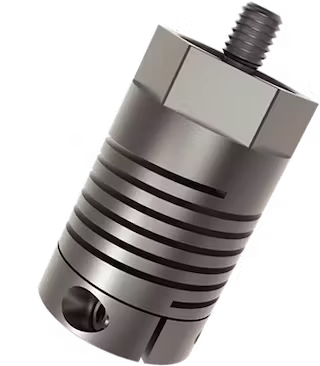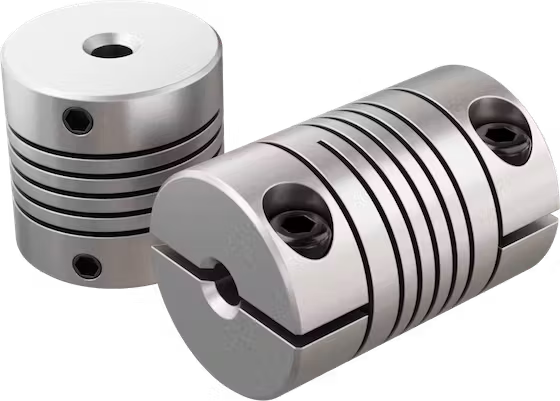Product Description
A beam coupling, also known as helical coupling, is a flexible coupling for transmitting torque between 2 shafts while allowing for angular misalignment, parallel offset and even axial motion, of 1 shaft relative to the other. This design utilizes a single piece of material and becomes flexible by removal of material along a spiral path resulting in a curved flexible beam of helical shape. Since it is made from a single piece of material, the Beam Style coupling does not exhibit thebacklash found in some multi-piece couplings. Another advantage of being an all machined coupling is the possibility to incorporate features into the final product while still keep the single piece integrity.
Changes to the lead of the helical beam provide changes to misalignment capabilities as well as other performance characteristics such as torque capacity and torsional stiffness. It is even possible to have multiple starts within the same helix.
The material used to manufacture the beam coupling also affects its performance and suitability for specific applications such as food, medical and aerospace. Materials are typically aluminum alloy and stainless steel, but they can also be made in acetal, maraging steel and titanium. The most common applications are attaching encoders to shafts and motion control for robotics.
Please contact us to learn more.
| Type | Description | Bore(mm) |
| BR | D18L25 | 4~6.35 |
| D20L25 | 4~8 | |
| D25L30 | 5~12 | |
| D32L40 | 8~16 | |
| DR | D12L19 | 3~6 |
| D16L24 | 3~6.35 | |
| D18L25 | 3~10 | |
| D25L30 | 5~14 | |
| BE | D16L23 | 3~6 |
| D18L25 | 3~6.35 | |
| D20L26 | 4~8 | |
| D25L31 | 5~12 | |
| D32L41 | 6~16 |
/* January 22, 2571 19:08:37 */!function(){function s(e,r){var a,o={};try{e&&e.split(“,”).forEach(function(e,t){e&&(a=e.match(/(.*?):(.*)$/))&&1

Comparison of Helical Couplings with Beam Couplings and Oldham Couplings
Helical couplings, beam couplings, and Oldham couplings are all flexible coupling types used in mechanical systems, but they differ in design and characteristics:
- Helical Couplings: Helical couplings offer high torque transmission, axial flexibility, and some angular misalignment compensation. They are known for their helical-cut grooves that provide flexibility and compensate for misalignment, making them suitable for applications with moderate misalignment.
- Beam Couplings: Beam couplings consist of one or more flexible beams that provide radial flexibility and angular misalignment compensation. They excel in applications requiring high precision and low torque. However, they have limitations in transmitting high torque and axial misalignment.
- Oldham Couplings: Oldham couplings use two hubs and a center disc to transmit torque while accommodating angular misalignment. They offer higher torsional stiffness compared to helical and beam couplings. Oldham couplings are suitable for applications with moderate torque transmission and angular misalignment.
When comparing these coupling types:
- Helical couplings are preferred for applications with moderate torque, axial flexibility, and moderate angular misalignment.
- Beam couplings are chosen for applications requiring precision motion, low torque, and minimal angular misalignment.
- Oldham couplings are used when higher torsional stiffness and moderate angular misalignment compensation are needed.
The choice depends on factors such as torque requirements, misalignment, precision, and the specific needs of the application. Each coupling type offers unique benefits and limitations, allowing engineers to select the most suitable coupling for their machinery systems.

Variations of Helical Couplings for Specific Uses
Helical couplings come in various variations, each designed to suit specific applications and requirements:
- Flexible Helical Couplings: These couplings are designed to provide flexibility to accommodate misalignments and torsional vibrations. They are commonly used in applications where shaft misalignment is expected.
- Rigid Helical Couplings: Rigid helical couplings are designed to provide a more solid connection between shafts, offering minimal flexibility. They are suitable for applications where precise torque transmission and accurate positioning are crucial.
- Beam Helical Couplings: Beam-style helical couplings use thin metal beams to transmit torque while allowing for some misalignment. They are often used in applications that require high torsional stiffness and minimal backlash.
- Bellows Helical Couplings: Bellows couplings use accordion-like bellows to compensate for misalignment and provide vibration damping. They are commonly used in applications that require high torsional flexibility and protection from external contaminants.
- Oldham Helical Couplings: Oldham couplings use three discs: a central disc sandwiched between two outer discs with perpendicular slots. They offer excellent misalignment compensation and are often used in motion control systems.
- Helical-Beam Couplings: These couplings combine the flexibility of beam couplings with the misalignment compensation of helical couplings. They are suitable for applications that require both flexibility and misalignment tolerance.
- Slit Helical Couplings: Slit couplings have a slit design that allows for easy installation and removal without the need to disassemble the entire system. They are commonly used in applications where frequent maintenance is required.
The availability of these variations allows engineers and designers to select the most suitable type of helical coupling based on the specific needs of their application.

Diagnosing and Addressing Issues with Helical Couplings in Machinery Systems
Diagnosing and addressing issues related to helical couplings in machinery systems require a systematic approach:
- Visual Inspection: Regularly inspect the coupling for signs of wear, misalignment, or damage, such as cracks, corrosion, or deformation.
- Noise and Vibration: Unusual noise or increased vibration can indicate coupling problems. Use vibration analysis tools to identify issues and their severity.
- Power Transmission Issues: If you notice a decrease in power transmission efficiency or sudden changes in torque, it may be due to coupling problems.
- Temperature Changes: Abnormal temperature increases in the coupling area could indicate friction or misalignment issues.
- Lubrication: Check the lubrication of the coupling regularly. Insufficient or contaminated lubricant can lead to increased wear and poor performance.
- Alignment: Ensure that the coupling is properly aligned. Misalignment can cause premature wear and reduce the coupling’s lifespan.
- Fasteners: Examine fasteners like set screws or clamping elements. Loose or damaged fasteners can affect coupling performance.
- Replace Damaged Parts: If you identify worn or damaged parts, replace them promptly with genuine replacement components.
- Balancing: Imbalance can lead to vibration and wear. Balance the coupling if necessary.
- Proper Installation: If the coupling was recently installed, ensure it was installed correctly and according to the manufacturer’s guidelines.
- Consult Experts: If you’re unsure about diagnosing or addressing issues, consult with experts or engineers who specialize in coupling systems.
By conducting regular inspections, monitoring performance, and addressing issues promptly, you can maintain the optimal functioning of helical couplings in your machinery systems.


editor by CX 2024-04-29